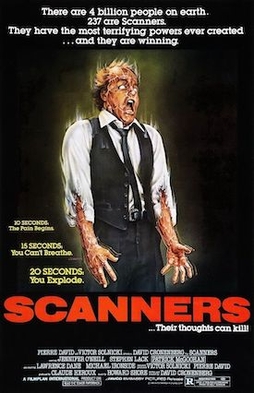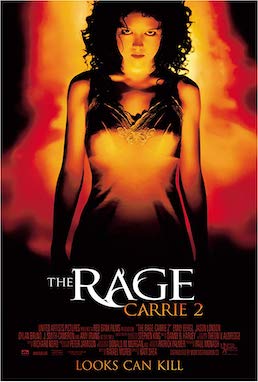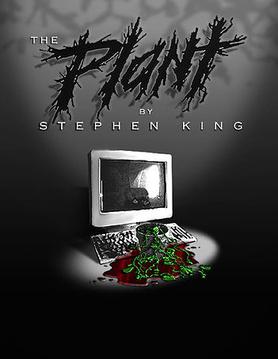"Young Zaphod Plays It Safe" is a short story by Douglas Adams set in his The Hitchhiker's Guide to the Galaxy universe. It is included with several collections but has never been released as a standalone work. It first appeared in The Utterly Utterly Merry Comic Relief Christmas Book (1986) which Adams also co-edited. A slightly revised version appeared in the 1996 anthology The Wizards of Odd, edited by Peter Haining. The story then appeared in some omnibus editions of The Hitchhiker's Guide to the Galaxy as well as the Adams retrospective The Salmon of Doubt.

Scanners is a 1981 Canadian science fiction horror film written and directed by David Cronenberg and starring Stephen Lack, Jennifer O'Neill, Michael Ironside, and Patrick McGoohan. In the film, "scanners" are psychics with unusual telepathic and telekinetic powers. ConSec, a purveyor of weaponry and security systems, searches out scanners to use them for its own purposes. The film's plot concerns the attempt by Darryl Revok (Ironside), a renegade scanner, to wage a war against ConSec. Another scanner, Cameron Vale (Lack), is dispatched by ConSec to stop Revok.

Memories is a 1995 Japanese animated science fiction anthology film with Katsuhiro Otomo as executive producer, and based on three of his manga short stories. The film is composed of three shorts: Magnetic Rose, directed by Studio 4°C co-founder Kōji Morimoto and written by Satoshi Kon; Stink Bomb, directed by Tensai Okamura and written by Otomo, and Cannon Fodder, written and directed by Otomo himself.

Quatermass and the Pit is a 1967 British science fiction horror film from Hammer Film Productions. It is a sequel to the earlier Hammer films The Quatermass Xperiment and Quatermass 2. Like its predecessors, it is based on a BBC Television serial, in this case Quatermass and the Pit, written by Nigel Kneale. The storyline, largely faithful to the original television production, centres on the discovery of ancient human remains buried at the site of an extension to the London Underground called Hobbs End. More shocking discoveries lead to the involvement of the space scientist Bernard Quatermass.
"The Screwfly Solution" is a 1977 science fiction short story by Raccoona Sheldon, a pen name for American psychologist Alice Sheldon, who was better known by her other nom de plume James Tiptree Jr. When the story was first published in June 1977, the identity of Alice Sheldon as both Tiptree and "Raccoona" Sheldon was unknown to the public or anyone in the science fiction community; a series of events triggered by the death of Sheldon's mother Mary Hastings Bradley in October 1977 resulted in the identity behind the pen-names being revealed by the end of the same year.

Village of the Damned is a 1995 American science fiction-horror film directed by John Carpenter, written by David Himmelstein, and starring Christopher Reeve, Linda Kozlowski, Kirstie Alley, Michael Paré, Mark Hamill, and Meredith Salenger. It is a remake of the 1960 film of the same name, itself based on the 1957 novel The Midwich Cuckoos by John Wyndham. The 1995 version is set in Northern California, whereas the book and original film are both set in England. The 1995 film was marketed with the tagline, "Beware the Children".
Death to the Daleks is the third serial of the 11th season of the British science fiction television series Doctor Who, which was first broadcast in four weekly parts on BBC1 from 23 February to 16 March 1974.

The Rage: Carrie 2 is a 1999 American supernatural horror film directed by Katt Shea, and starring Emily Bergl, Jason London, Dylan Bruno, J. Smith-Cameron and Amy Irving. The film is a sequel to the 1976 horror film Carrie based on the 1974 novel of the same name by Stephen King, and serves as the second film in the Carrie franchise. The film was originally titled The Curse and did not have connections to the Carrie novel or film, but was eventually rewritten to be a direct sequel to the 1976 film. Its plot follows the younger half-sister of Carrie White (Bergl), also suffering with telekinesis, who finds that her best friend's suicide was spurred by a group of popular male classmates who exploited her for sexual gain.
"Let's Get Together" is a science fiction short story by American writer Isaac Asimov. It was originally published in the February 1957 issue of Infinity Science Fiction, and included in the collections The Rest of the Robots (1964) and The Complete Robot (1982). The robots in this tale are very different from Asimov's norm, being quite willing to work as war machines. The tale is also based on a continuation of Cold War hostility, rather than the peaceful unified world of most of the robot stories.

Déjà Vu is a 2006 American science fiction action film directed by Tony Scott, written by Bill Marsilii and Terry Rossio, and produced by Jerry Bruckheimer. The film stars Denzel Washington, Paula Patton, Jim Caviezel, Val Kilmer, Adam Goldberg and Bruce Greenwood. It involves an ATF agent who travels back in time in an attempt to prevent a domestic terrorist attack that takes place in New Orleans and to save a woman with whom he falls in love.
Peter Van Greenaway (1927–1988) was a British novelist, the author of numerous thrillers with elements of horror and satire.

The Nightmare of Black Island is a BBC Books original novel written by Mike Tucker and based on the long-running science fiction television series Doctor Who. It was published on 21 September 2006, alongside The Art of Destruction and The Price of Paradise. It features the Tenth Doctor and Rose.
Telek is a science fiction novella about telekinesis by American author Jack Vance. It was first published in the January 1952 issue of Astounding Science Fiction.

Confirm or Deny is a 1941 war drama film directed by Archie Mayo and starring Don Ameche, Joan Bennett and Roddy McDowall. It was produced and distributed by Hollywood studio 20th Century Fox. The screenplay was written by Jo Swerling, based on a story by Samuel Fuller and Henry Wales. An uncredited Fritz Lang worked on the film as director.

A mass casualty incident describes an incident in which emergency medical services resources, such as personnel and equipment, are overwhelmed by the number and severity of casualties. For example, an incident where a two-person crew is responding to a motor vehicle collision with three severely injured people could be considered a mass casualty incident. The general public more commonly recognizes events such as building collapses, train and bus collisions, plane crashes, earthquakes and other large-scale emergencies as mass casualty incidents. Events such as the Oklahoma City bombing in 1995, the September 11 attacks in 2001, and the Boston Marathon bombing in 2013 are well-publicized examples of mass casualty incidents. The most common types of MCIs are generally caused by terrorism, mass-transportation accidents, fires or natural disasters. A multiple casualty incident is one in which there are multiple casualties. The key difference from a mass casualty incident is that in a multiple casualty incident the resources available are sufficient to manage the needs of the victims. The issue of resource availability is therefore critical to the understanding of these concepts. One crosses over from a multiple to a mass casualty incident when resources are exceeded and the systems are overwhelmed.

The Plant is an unfinished serial novel by American writer Stephen King, published in 1982–1985 privately and in 2000 as a commercial e-book.

"Fracture" is the third episode of the second season of the American science fiction drama television series Fringe. The episode followed the Fringe team's investigation into a man who mysteriously hardens and then explodes, killing those around him. The case leads them to a secret government project and an AWOL colonel.

"The Guided Man" is a classic science fiction short story by L. Sprague de Camp. It was first published in the magazine Startling Stories for October, 1952. It first appeared in book form in the collection A Gun for Dinosaur and Other Imaginative Tales. It has also appeared in Science Fiction Yearbook no. 3 and the collection The Best of L. Sprague de Camp. The story has been translated into German.

A Nightmare on Elm Street: The Dream Dealers is a 2006 British science fiction horror novel written by Jeffrey Thomas and published by Black Flame. A tie-in to the Nightmare on Elm Street series of American horror films, it is the fifth and final installment in a series of five Nightmare on Elm Street novels published by Black Flame and is set in a future where technological advancement has allowed for the recording and reliving of dreams, attracting the attention of supernatural killer Freddy Krueger.













